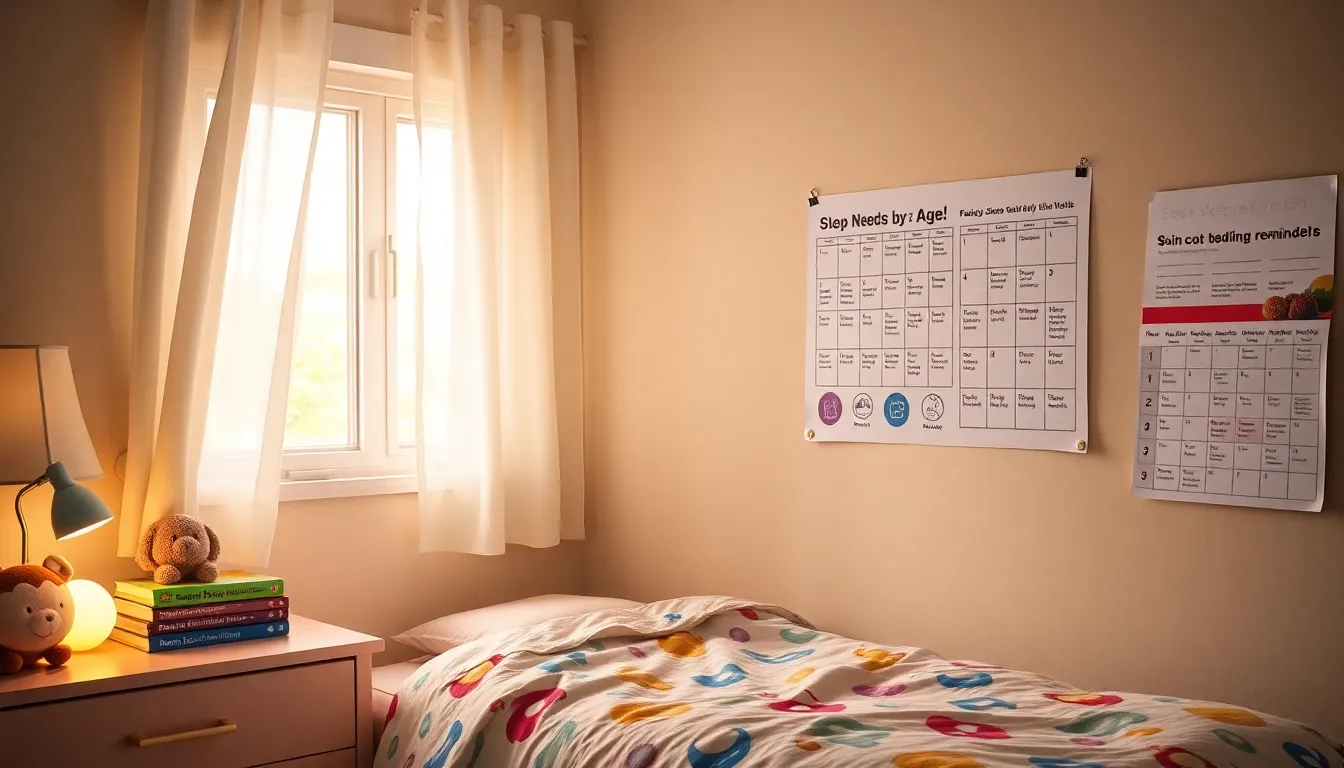Let’s face it, getting kids to sleep can feel like trying to herd cats. As fun as that might sound, it’s not the most effective bedtime strategy. Kids have unique sleep needs, and navigating their nightly routines can be a challenge for even the most seasoned parents. Thankfully, with the right strategies in place, you can transform chaotic bedtimes into peaceful nighttime rituals. Here are some cleverly crafted sleep tips for kids that will have all the little ones dreaming effortlessly from dusk till dawn, leaving you plenty of quiet time to enjoy your own well-deserved rest.
Table of Contents
ToggleUnderstanding Children’s Sleep Needs

Sleep is as essential for kids as broccoli is for their growth (even if they often decide that broccoli is not their friend). Understanding how much sleep children need is the first step in ensuring they’re getting enough rest. Here’s a breakdown of average sleep requirements by age:
- Newborns (0–3 months): 14–17 hours
- Infants (4–11 months): 12–15 hours
- Toddlers (1–2 years): 11–14 hours
- Preschoolers (3–5 years): 10–13 hours
- School-age children (6–13 years): 9–11 hours
- Teenagers (14–17 years): 8–10 hours
These figures vary per child, and some might need a little more or less sleep. But generally speaking, ensuring they hit these milestone hours is pivotal for their physical growth, cognitive learning, and emotional well-being. A well-rested child is often more focused, happier, and ready to conquer new challenges, like that math assignments they keep pretending to forget.
Establishing a Bedtime Routine
When it comes to bedtime, consistency is key. Creating a nightly routine helps signal to children that it’s time to wind down and prepare for sleep. Here are some fun yet effective strategies:
- Set a fixed bedtime: Keep it consistent, even on weekends. This helps regulate their internal clocks.
- Wind down together: Spend 15–30 minutes engaging in calming activities, such as reading a story or drawing.
- Bath time fun: A warm bath can be a delightful way to help relax those busy little bodies.
- Create a bedtime checklist: Kids love checklists. Involve them in the process, brush teeth, put on pajamas, and turn off the lights.
Incorporating these elements into a routine will create predictability, making the transition to sleep easier for children. Plus, bedtime may turn into that sacred time where the wildest stories unfold as you both investigate into imaginary worlds.
Creating a Sleep-Friendly Environment
A sleep-friendly environment goes a long way in promoting restful nights. Consider transforming your child’s sleeping space to nurture tranquility:
- Dim the lights: Soft lighting creates a cozy and calm atmosphere. Consider blackout curtains to block any pesky street lights.
- Cool it down: Ideal room temperature is between 68 and 72°F. A cooler room often helps in achieving deeper sleep.
- Comfortable bedding: Invest in beds and pillows that support a good night’s sleep. This could be the difference between a restful night and a restless one.
- Keep noise levels down: Use white noise machines or fans to drown out disruptive sounds. Nobody wants to become a detective in the middle of the night.
Creating a sanctuary for sleep can have lasting benefits, setting the stage for peaceful nights and energized mornings.
Nutrition and Sleep Connection
What children eat throughout the day can significantly influence their ability to fall asleep at night. While cookies and sugar-filled snacks may cause temporary happiness, they can lead to a sugar crash that disrupts sleep. Here are some nutritional guidelines:
- Balanced meals: Incorporating proteins, healthy fats, and fiber-rich carbohydrates helps sustain energy levels without the sugar spikes.
- Avoid caffeine: Keep coffee, tea, and chocolate off the menu, especially after lunchtime. Caffeine can linger and keep kids awake longer than desired.
- Light evening snacks: If hunger strikes close to bedtime, provide nutritious snacks like bananas or yogurt. These can promote sleepiness without overloading their bellies.
Eating well during the day can prepare kids for a restful night, ensuring their sleep cycle isn’t upset by poor food choices.
Managing Screen Time Before Bed
In today’s digital age, screens are everywhere, and they’re only begging for little fingers to tap and swipe. Unfortunately, excessive screen time, especially before bed, can seriously hinder sleep quality due to the blue light emitted by devices. To combat this, parents can:
- Establish ‘tech-free’ zones: Make bedrooms a sanctuary free of devices. They should be solely about sleep and dreaming.
- Create a device curfew: Encourage kids to turn off screens at least an hour before bed. Instead of binge-watching, investigate into books or engage in crafts.
- Model behavior: Parents can lead by example. When your little ones see you disconnecting from technology, they’re likely to follow suit.
Setting clear boundaries related to screen use can encourage healthier bedtime habits. It’s time for the family to rediscover the joy of books.
Dealing With Sleep Challenges
Ah, the inevitable sleep challenges that arise. From nightmares and anxiety to resistance and refusal, many kids experience difficulties at bedtime. Here’s how to tackle these issues effectively:
- Stay calm and consistent: When faced with classic stalling tactics, maintain a firm, calm demeanor. Your confidence can reassure anxious little ones.
- Talk it out: Allow children to express any fears. Understanding their concerns helps in calming their minds before sleep.
- Carry out transitional objects: Stuffed animals or night lights can provide comfort, acting as physical representations of safety.
Navigating sleep challenges requires patience, and parents must tailor their approach to suit each child’s unique needs.
Encouraging Relaxation Techniques
The importance of relaxation techniques cannot be overstated. Encouraging children to engage in peaceful practices before bed can pave the way for restful nights. Here are a few practices to consider:
- Deep breathing exercises: Teach them to take slow, deep breaths. Inhale through the nose, hold for a few seconds, and exhale through the mouth. This technique can help calm their racing minds.
- Gentle stretches: Simple stretching or yoga can relieve tension built up during the day. Even five minutes can make a huge difference.
- Mindfulness practices: Engage them in visualizing a peaceful beach or a magical forest. Guided sleep meditations tailored for kids are also widely available, allowing them to drift off while exploring calming imagery.
Incorporating these techniques fosters a serene mindset, priming children for sleep and relaxation.




